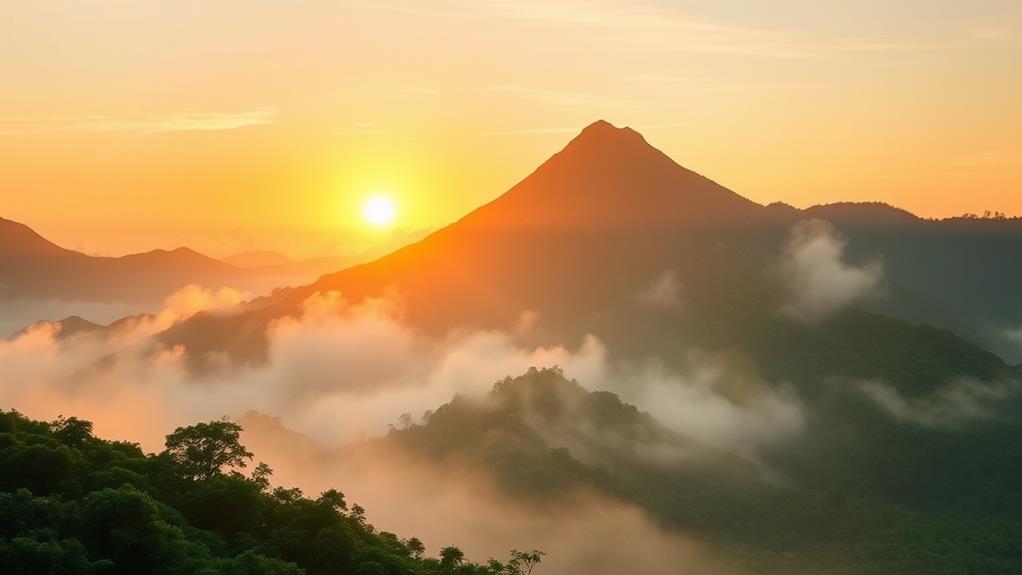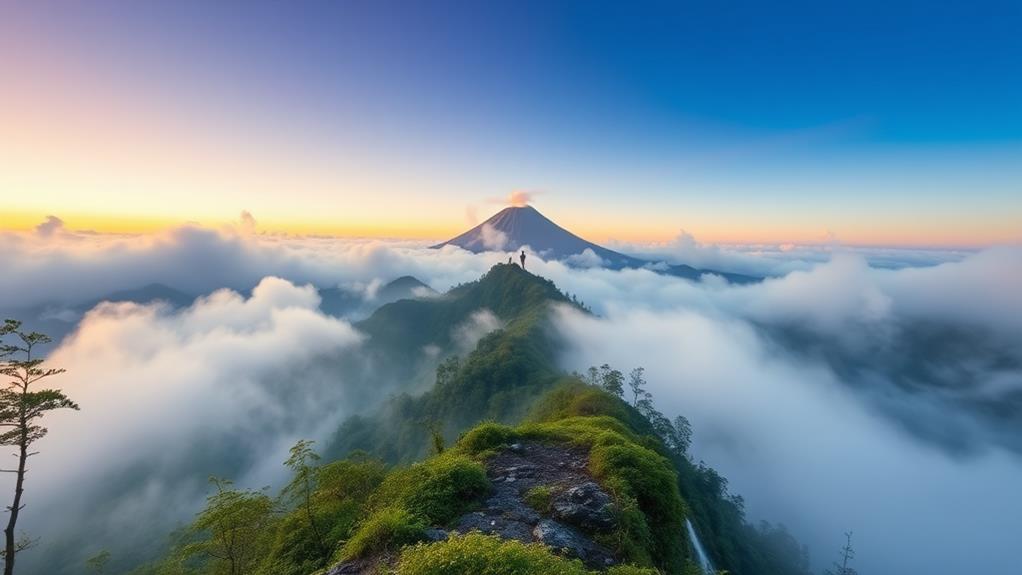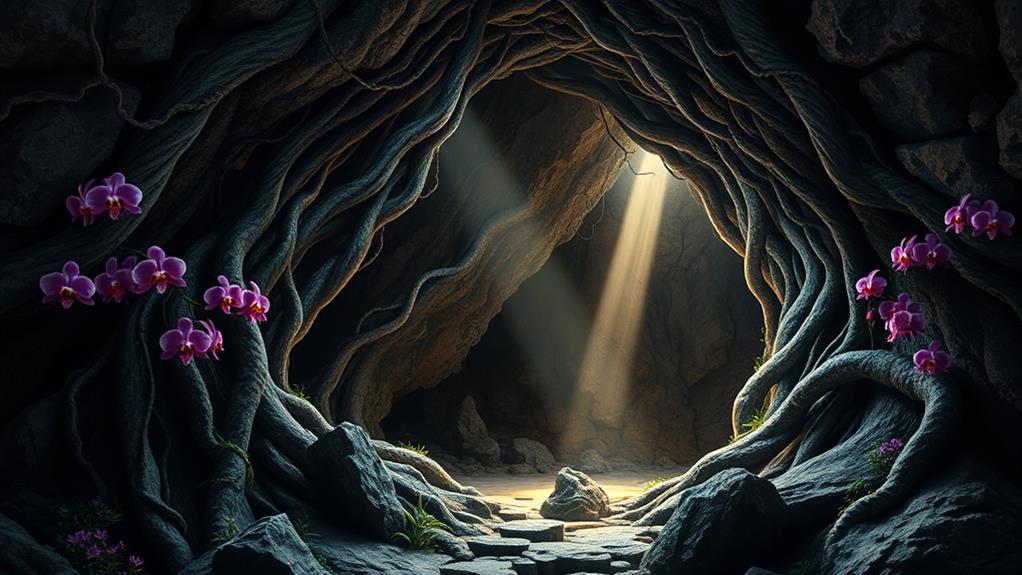Mount Banahaw: A Sacred Mountain Steeped in Legend and Spirituality
Mount Banahaw is a revered site in Tagalog culture where mystical legends and spiritual energies are deeply intertwined with the natural world. Rich folklore and supernatural encounters have shaped the spiritual beliefs of the local community, highlighting the importance of cultural heritage preservation.
As you prepare to ascend the mountain, you'll encounter natural springs believed to possess mystical healing abilities. These springs are a vital part of the local spiritual practices, where visitors can immerse themselves in rituals and traditions that balance physical and spiritual rejuvenation.
For instance, the locals believe that the springs' healing properties can cure various ailments, from skin diseases to spiritual afflictions.
As you venture deeper into the mountain, you'll uncover the secrets of this sacred site, including its mystical legends and spiritual significance. The mountain's unique energy is thought to have a profound impact on those who visit, promoting spiritual growth, self-reflection, and inner peace.
With each step, the mysteries of Mount Banahaw will slowly unfold before you, revealing a deeper understanding of this sacred mountain and its importance in Tagalog culture.
Sacred Mountain of Tagalog Legends

Mount Banahaw: A Sacred Mountain Steeped in Tagalog Legends
Mount Banahaw holds a revered position in Tagalog culture as a sacred mountain, rich in legends and mystique. This sacred mountain is believed to be a site of spiritual energy and healing, attracting numerous pilgrims and mystics each year. Some believe that the mountain is the dwelling place of supernatural beings, and its lush forests and waterfalls are believed to possess mystical properties. Pilgrims who make the journey to Mount Banahaw often seek to tap into this spiritual energy and explore the natural wonders that are said to be scattered throughout the mountain. Many also participate in cleansing rituals and meditation practices to further connect with the spiritual essence of the mountain.
The mountain's mystical reputation is further enriched by the numerous legends associated with it. One legend tells the story of a hermit who established Mount Banahaw as a spiritual center, solidifying its significance in Tagalog culture.
Other legends include stories of miraculous events and encounters with supernatural beings such as diwata (fairies) and other spirits.
These legends have contributed to the mountain's reputation as a site of spiritual and miraculous healing, making it a revered destination for those seeking physical, emotional, and spiritual restoration.
Mystical Energies and Healing Springs
Mount Banahaw's Mystical Energies and Healing Springs
Mount Banahaw is a sacred mountain renowned for its spiritual and miraculous healing properties.
The mountain's reputation converges with the natural world, attracting pilgrims seeking physical and spiritual restoration. The natural springs on the mountain are believed to possess mystical healing abilities, making them a popular destination for those seeking rejuvenation.
The Blessed Water springs are particularly sought after for their reputed healing properties. These springs are often used for bathing to rejuvenate both body and spirit.
Rituals conducted at these healing springs typically involve bathing and prayer, enhancing the spiritual experience and reinforcing the mountain's sacred reputation.
According to local legends, supernatural beings and energies contribute to the mountain's mystical aura. This makes it a popular site for mystics and psychics.
Visitors often report experiencing unusual sensations of calm and tranquility, as well as encounters with unexplained phenomena. These experiences further solidify Mount Banahaw's status as a site of mystical energy.
Spiritual Significance and Pilgrimages

Mount Banahaw's spiritual significance extends beyond its mystical energies and healing springs, attracting pilgrims seeking a deeper connection with the divine. This significance is evident in the mountain's sacred sites, which are integral to a spiritual journey.
For instance, the Templo Cave serves as a space for introspection and divine connection, where pilgrims can reflect and pray amidst flickering candles.
The Cave of Judgement is another sacred site, shrouded in an aura of spiritual reflection and penance, where pilgrims can confront their inner selves and seek forgiveness.
During Holy Week, throngs of pilgrims flock to Mount Banahaw, seeking spiritual rejuvenation and restoration. The mountain's healing springs, believed to possess miraculous properties, become a focal point of their pilgrimage, offering both physical and spiritual healing.
The mystical atmosphere of Mount Banahaw is further enhanced by local lore, which tells of supernatural beings and divine encounters. These stories deepen the spiritual experience, fostering a sense of connection with the divine.
As a result, Mount Banahaw remains a revered site for locals and pilgrims alike.
Geological Wonders and Volcanic Activity
Mount Banahaw's Geological Composition
Mount Banahaw is a stratovolcano standing 2,158 meters tall, composed of andesitic to dacitic materials.
Its unique geological composition is the result of historical basalt eruptions. This complex structure has been shaped by millions of years of explosive events and gradual transformations.
Volcanic Activity and Formation
Mount Banahaw is part of the Macolod Corridor, a volcanically active region featuring multiple satellite cones, including San Cristobal and Banahaw de Lucban.
The mountain has experienced two primary explosive activity periods: one occurring between 2.0-1.4 million years ago and another from 0.5 million years ago to the present. These periods of activity have contributed to its formation.
Geological Formations and Historical Significance
Mount Banahaw's geological formations are equally impressive, with caves and springs that hold historical significance.
Although its last eruption was recorded in the early 1700s, Mount Banahaw remains an awe-inspiring testament to the region's volcanic past and its ongoing geological evolution.
Environmental Concerns and Risks

Mount Banahaw's Environmental Concerns
The growing number of visitors to Mount Banahaw poses a significant threat to the environment. 93,000 residents live within 10 km, and 24 million within 100 km, increasing the risk of environmental degradation and pollution. The sacred site's water quality is a particular concern, as the influx of visitors can contaminate the mountain's sacred springs and waterfalls.
Sustainable Practices are Crucial
To protect Mount Banahaw's vital resources, sustainable practices must be adopted. This includes responsible waste management and conservation efforts to prevent environmental degradation.
Education on volcanic hazards and risks associated with the area is also necessary, especially during peak seasons when the risk of volcanic activity is higher.
Balancing Tourism with Environmental Protection
The unique ecosystems and biodiversity of Mount Banahaw are vulnerable to the impacts of increased human interaction.
To balance tourism with environmental protection, responsible tourism practices must prioritize the preservation of this sacred site. This includes adopting measures to reduce waste, minimize pollution, and promote conservation efforts.
Local Customs and Traditions Respected
Mount Banahaw is a sacred space where local customs and traditions reign supreme.
When venturing into Mount Banahaw, it's essential to respect the cultural heritage of the indigenous communities that call it home. To ensure a harmonious and enriching experience, refrain from littering and stick to designated trails to preserve the mountain's sacred nature.
Participate in rituals like prayer and candle lighting at altars near Santa Lucia Falls, which reflect the community's deep spiritual connection to the mountain.
Recognize the mountain as a dwelling place for ancestral spirits, and avoid breaking regulations that might be seen as disrespectful to local traditions.
Engage with local guides who share stories and teachings about the mountain's sacredness, emphasizing the importance of understanding and honoring the spiritual beliefs of the indigenous communities.
Exploring Caves and Natural Formations

Mount Banahaw's Caves and Natural Formations Hold Spiritual Significance
The caves and natural formations of Mount Banahaw are steeped in spiritual significance, with unique volcanic rock structures shaped by historical eruptions and erosion.
The Cave of Judgment is a notable example, associated with spiritual reflection and penance, where pilgrims come to confront their inner truths.
Some caves are believed to be inhabited by hermits and spiritual beings, contributing to the mountain's rich folklore.
The Templo Cave, located near sacred sites, serves as a prayer area with altars for locals to light candles and engage in rituals.
The natural formations surrounding the mountain are equally impressive.
Santa Lucia Falls, a waterfall featuring two distinct cascades, is considered a sacred and healing site.
These natural wonders add to the spiritual allure of Mount Banahaw, making it a unique destination for those seeking to uncover its mystical energies.
Folklore and Ancient Rituals Unveiled
Mount Banahaw: A Sacred Site Rich in Folklore and Ancient Rituals
Mount Banahaw is a site of great cultural significance, boasting a rich tapestry of folklore and ancient rituals. The mountain's spiritual attribute resonates deeply with the local community.
Supernatural Beings and Miraculous Events
Mount Banahaw's folklore is filled with stories of supernatural beings, such as diwata, and legends of miraculous events and divine encounters. These stories have been passed down through generations, shaping the local community's spiritual beliefs.
Rituals and Practices
Rituals at Mount Banahaw often involve bathing in its healing springs, with visitors seeking spiritual rejuvenation and good fortune.
The Cave of Judgement is a significant site for spiritual reflection, where visitors confront their inner truths and seek forgiveness. Local traditions include seeking permission from spirits and engaging with shamans before embarking on treks, highlighting the cultural respect for the mountain's mystical heritage.
Healing Properties and Spiritual Significance
Mount Banahaw's healing properties and spiritual significance have made it a revered site, attracting pilgrims and mystics who believe in its mystical powers.
The mountain's ability to heal and bring spiritual growth has been a driving force behind its cultural significance.
Preserving the Sacred Site
These ancient rituals and folklore have been woven into the fabric of local culture, highlighting the importance of preserving this sacred site for future generations.
It is crucial to protect Mount Banahaw's cultural heritage to ensure its spiritual significance endures.
Are the Mystical Legends of Mount Banahaw Similar to the Sunrise Chasing Experience at Mount Pulag?
The mystical legends of Mount Banahaw are entirely different from the experience of chasing sunrise above clouds at Mount Pulag. Banahaw’s folklore is steeped in mystical traditions, while the sunrise view from Pulag offers a breathtaking sight above the clouds, which is a unique and unforgettable experience for hikers.
Conservation Efforts and Visitor Tips

Preserving Mount Banahaw's Sacred Sites
Mount Banahaw's conservation efforts focus on educating visitors about the area's ecological and spiritual significance to promote sustainable tourism practices.
As a national park since 1921, it's crucial to respect the mountain's sacred nature and ecological integrity.
Eco-Friendly Habits for Visitors
To contribute to conservation efforts, practice eco-friendly habits by avoiding littering and using established trails to protect the diverse ecosystems and sacred sites within the park.
Local regulations prohibit harmful activities like smoking and littering, so be sure to follow the rules.
Preparing for a Smooth Trip
To ensure a smooth and enjoyable trip, prepare thoroughly by bringing appropriate gear, sufficient water, and snacks.
Be aware of local customs that enhance the visitor experience.
Consider joining guided tours, which provide insights into the cultural practices and ecological features of the area, allowing you to deepen your understanding of Mount Banahaw's spiritual significance and natural beauty.
Frequently Asked Questions
What Is the Mythology of Mount Banahaw?
Mount Banahaw's mythology is deeply rooted in spiritual significance. This sacred site in the Philippines is home to mythical creatures like diwata, believed to possess healing powers.
According to local legends, diwata are gentle, benevolent beings that inhabit the mountain's forests and streams.
The mountain's spiritual significance attracts seekers of healing and enlightenment. Many visit Mount Banahaw to perform sacred rituals, which grant permission to tap into the mountain's restorative energies.
These rituals, often led by local shamans, involve offerings and prayers to appease the spirits and harness the mountain's power.
Legends and mystical encounters have cemented Mount Banahaw's status as a revered cultural icon. Local stories tell of miraculous healings, spiritual awakenings, and encounters with the diwata.
These stories have been passed down through generations, solidifying the mountain's reputation as a place of spiritual power and transformation.
What Is Special About Mount Banahaw?
Mount Banahaw's Spiritual Significance
Mount Banahaw is a sacred site that offers a unique pilgrimage experience.
Its healing waters and ecological diversity create an atmosphere conducive to spiritual retreats, allowing individuals to disconnect from the world and reconnect with their inner selves.
This convergence of natural and spiritual elements makes Mount Banahaw an ideal location for self-discovery and introspection.
What Is the Meaning of Banahaw?
The name "Banahaw" originates from the Tagalog word "buhaw", meaning "to be born".
This etymology reflects the mountain's significance as a source of life and spiritual rejuvenation. In local traditions, Banahaw is deeply rooted in the cultural heritage of the Philippines, making it a sacred site for spiritual pilgrimage.
The name embodies the essence of renewal.
This aligns with the mountain's reputation for healing and divine connection. The mountain is considered a source of life and spiritual rejuvenation, which is reflected in its name.
How Many Times Did Mount Banahaw Erupt?
Mount Banahaw has experienced explosive activities during two primary periods. Historical records show that the mountain has had multiple eruptions, but the exact count is unknown.
The last recorded eruption was in 1730, which formed the current crater lake. Due to its proximity to populated areas, it's essential to monitor Mount Banahaw's volcanic activity.
Understanding its geological significance and historical eruptions helps appreciate the local folklore surrounding this sacred mountain.